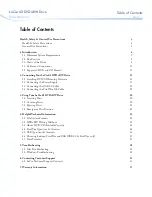
8
https://www.toshiba.com/tic/
System Characteristics
• A motor with a rated capacity that exceeds the
motor capacity recommended for the ASD.
• An explosion-proof motor.
When using the ASD with an explosion-proof motor
or other special motor types, lower the carrier
frequency to stabilize the operation.
DO NOT
set
the carrier frequency below 2.2 kHz if operating the
system in the vector control mode.
Note: When operating in the Vector Control
mode the carrier frequency should be
set to 2.2 kHz or above.
If the motor being used is coupled to a load that has
a large backlash or if coupled to a reciprocating
load, use one of the following procedures to
stabilize motor operation.
• Adjust the S-Pattern acceleration/deceleration
setting,
• If operating in the Vector
control mode, adjust the
response time, or
• Switch to the Constant Torque
control mode.
Motor Braking
The motor may continue to rotate and coast to a
stop after being shut off due to the inertia of the
load. If an immediate stop is required, a braking
system should be used. For further information on
braking systems see
.
Q9 Plus ASD Characteristics
Over-Current Protection
Each Q9 Plus ASD
model is designed for a
specified operating power range. The Q9 Plus ASD
will incur a trip if the design specifications are
exceeded.
However, the Q9 Plus ASD may be operated at
110% of the specified output-current range for a
limited amount of time as indicated in the section
titled
Voltage/Current Specifications on pg. 280
.
Also, the
) may be
adjusted to help with nuisance over-current trips.
When using the Q9 Plus ASD for an application that
controls a motor which is rated significantly less
than the maximum current rating of the Q9 Plus
ASD, the over-current limit setting will have to be
changed to match the application. See
for further information
on this ASD/motor configuration.
ASD Capacity
The Q9 Plus ASD must not be used with a motor
that has a significantly larger capacity, even if the
motor is operated under a small load. A Q9 Plus
ASD being used in this way will be susceptible to a
high-output peak current which may result in
nuisance tripping.
Do not apply a level of input voltage to a Q9 Plus
ASD that is beyond that which the Q9 Plus ASD is
rated. The input voltage may be stepped down
when required with the use of a step-down
transformer or some other type of voltage reduction
system.
Using Vector Control
Using Vector Contro
l
enables the system to
produce very high torque over the entire operating
range even at extremely low speeds. Vector
Control
may be used with or without feedback. However,
using feedback increases the speed accuracy for
applications requiring precise speed control.
Enabling the Automatic Energy Savings further
increases the efficiency of the Q9 Plus ASD while
maintaining its robust performance.
Vector Control is not capable of operating multiple
motors connected in parallel.
See
using Vector Control.
Local/Remote Operation
While running in the Local mode at a non-zero
speed, if the RJ45 connector is removed from the
EOI, the Q9 Plus ASD remains in the Local
mode
running at the last commanded speed even though
the Local LED is off. The Q9 Plus ASD output
remains at the frequency of the Frequency
Command field at the time of the disconnect for the
duration of the disconnect.
To prevent this condition, before disconnecting the
RJ45 connector, ensure that the Q9 Plus ASD is off.
CAUTION
Summary of Contents for DN-68249-003
Page 1: ...ADJUSTABLE SPEED DRIVES Q9 DN 68249 003 INSTALLATION OPERATION MANUAL April 2020 ...
Page 2: ......
Page 3: ...Document Number 68249 003 April 2020 Q9 Plus ASD Installation Operation Manual ...
Page 4: ......
Page 12: ...Table of Contents Q9 Plus ASD Install Op Manual iv https www toshiba com tic ...
Page 305: ......
















































